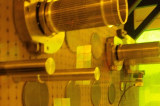- Home
- Research
- Education & Outreach
- Facilities
- Industry
Nanoscale Devices, Systems, & Metrology (TRG 2)
Co-Leaders
Csaba Andras Moritz and Mark T. Tuominen
Participating Faculty
Katherine Aidala (Mount Holyoke College), Alexi Arango (Mount Holyoke College), Alejandro L. Briseno (PSE), and Janice Hudgings (Mount Holyoke College)
TRG 2, Nanoscale Devices, Systems, and Metrology, supports fundamental studies in magnetics, photonics and device design to generate proof-of-concept prototypes that can be assembled using advances from TRG 1 and the CHM's process platforms. It provides a balanced complement of theoretical and experimental components to guide a system-level design-for-manufacturing approach and the development of metrology methods for property characterization and nanomanufacturing control. Specific efforts include the development of high magnetic permeability ("high-µ") effective medium materials for high frequency wireless device applications, nanoscale device fabrics for computation, and plasmonic arrays for optical sensors based on the CHM's self-assembly and additive driven assembly platforms. The TRG also develops new metrology techniques based on thermoreflectance microscopy.
Current TRG 2 Research
Nanostructure Designs for Magnetic Data Storage Applications
- Development of patterned arrays of magnetic elements for use in highly magnetic media with very tight tolerances on distributions in position, size and magnetic properties.
- Wafer-scalable nanomanufacturing process developed to produce magnetic nanorings with any chosen diameter in the 13-200 nm range, representing the smallest man-made rings on record. Both symmetric and antisymmetric ring designs have been evaluated for the ability to provide clockwise and counterclockwise remanant magnetization states.
- Study of precise magnetic clusters as candidate elements for multistate data storage. The multistate physics of these clusters have been verified by micromagnetic simulations and clusters are being fabricated for read-write testing experiments.
Microprocessor Designs for Nanoscale Application-Specific Integrated Circuits (NASICs)
- Design and reduction-to-practice of 2-D semiconductor-nanowire based fabric processor. The first version of a Wire-Streaming Processor (WISP-0) has been designed and density-optimized.
- Initial versions of tools for circuit-level simulation, CAD, yield and defect simulation for NASICs have been developed. New techniques are being explored to improve manufacturability and reduce device requirements.
- WISP-0 maintains 3-4X density advantage over 18-nm CMOS technology expected in 2018 despite the overhead of built-in defect tolerance at multiple levels. The approach does not need reconfigurable devices or complicated interfacing between CMOS and nano layers, and it scales with improvements in nanomanufacturing.
- Experimental fabrication and testing of circuit prototypes is underway between TRG 1 and TRG 2.
Silicon-Nanocrystal-Embedded Wide-Band-Gap Oxide Thin Film Nanostructures
- Silicon nanocrystal films with 5-7 nm cluster sizes synthesized by RF plasma co-sputtering and in situ sequestration in wide band gap ZnO and SiO2 film matrices indicate optical switching functionality in nc-Si nanostructures, with potential application in optical computing. Further research to characterize silicon nanocrystal morphology is ongoing.
- TRG 2 initial studies are an important step in the direction of establishing the feasibility of ZnO light-emitting device integrated with silicon. Because of compatibility with silicon IC process technology, these systems are envisioned for chip-to-chip optical interconnects having enormous implication in realizing steep enhancement in computation speeds.
Thermoreflectance Microscopy (TRM) for Characterization Under Operating Conditions
- TRM offers a fast 2D image with high spatial (250 nm) and thermal (10 mK) resolution that can identify defects, hotspots and material inhomogeneities by temperature profiling.
- Research has identified defects in a photonic circuit comprised of cascaded semiconductor optical amplifiers and the radial temperature distributions of vertical cavity surface emitting lasers (VCSELs) as a function of bias power.
- TRM is also used to help evaluate how thermal effects limit output power and cause variations in the threshold current. Plans are underway to analyze the spatial and temperature resolution of metallic fabricated using electron beam lithography.
Optical Spectroscopy of Semiconductor, Metal and Organic Nanostructures
- Studies of carrier and energy relaxation dynamics of nanostructures and the dynamics of interfacial interactions in hybrid excitonic/plasmonic materials.
- Understanding this behavior in functional nanomaterials will promote the implementation of these materials in solid-state lighting, sensor, and light-harvesting applications (e.g. solar cells).
- Use of ultrafast Ti-sapphire laser with 20-50 fs pulse duration in the 750 - 850 nm wavelength range to help understand how plasmonic structures interact with optical dipoles. A research objective is design of plasmon-exciton hybrid nanostructures with specific properties as a result of the combination of different materials on the nanoscale.
Fluorescence Involving Quantum Dots
- Understanding the mechanism of fluorescence intermittency (so-called “blinking”) and its statistical behavior in single quantum dot photoluminescence is a key issue in development of viable nanotechnologies involving quantum dots. Current experimental and theoretical research focuses on modified fluorescence intensity statistics mediated by the presence of conjugated organic ligands at the quantum dot surface.
- Results showing nearly complete suppression of blinking as well as coverage-specific “memory” in the luminescence dynamics are believed to be strongly dependent on the surface physics of the dot structure. Continued experiments and simulations can give an insight into long-term behavior of qdots, with potential impact in optoelectronic, bioelectronic, and photovoltaic applications.













